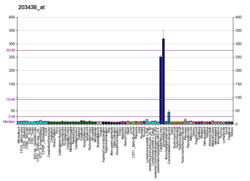STC2
Stanniocalcin-2 is a protein that in humans is encoded by the STC2 gene.[5][6][7]
This gene encodes a secreted, homodimeric glycoprotein that is expressed in a wide variety of tissues and may have autocrine or paracrine functions. The encoded protein has 10 of its 15 cysteine residues conserved among stanniocalcin family members and is phosphorylated by casein kinase 2 exclusively on its serine residues.
Its C-terminus contains a cluster of histidine residues which may interact with metal ions. The protein may play a role in the regulation of renal and intestinal calcium and phosphate transport, cell metabolism, or cellular calcium/phosphate homeostasis. Constitutive overexpression of human stanniocalcin 2 in mice resulted in pre- and postnatal growth restriction, reduced bone and skeletal muscle growth, and organomegaly. Expression of this gene is induced by estrogen and altered in some breast cancers.[7]
References
- GRCh38: Ensembl release 89: ENSG00000113739 - Ensembl, May 2017
- GRCm38: Ensembl release 89: ENSMUSG00000020303 - Ensembl, May 2017
- "Human PubMed Reference:". National Center for Biotechnology Information, U.S. National Library of Medicine.
- "Mouse PubMed Reference:". National Center for Biotechnology Information, U.S. National Library of Medicine.
- Chang AC, Reddel RR (Nov 1998). "Identification of a second stanniocalcin cDNA in mouse and human: stanniocalcin 2". Mol Cell Endocrinol. 141 (1–2): 95–9. doi:10.1016/S0303-7207(98)00097-5. PMID 9723890.
- Ishibashi K, Miyamoto K, Taketani Y, Morita K, Takeda E, Sasaki S, Imai M (Nov 1998). "Molecular cloning of a second human stanniocalcin homologue (STC2)". Biochem Biophys Res Commun. 250 (2): 252–8. doi:10.1006/bbrc.1998.9300. PMID 9753616.
- "Entrez Gene: STC2 stanniocalcin 2".
Further reading
- DiMattia GE, Varghese R, Wagner GF (1999). "Molecular cloning and characterization of stanniocalcin-related protein". Mol. Cell. Endocrinol. 146 (1–2): 137–40. doi:10.1016/S0303-7207(98)00163-4. PMID 10022771.
- Moore EE, Kuestner RE, Conklin DC, et al. (1999). "Stanniocalcin 2: characterization of the protein and its localization to human pancreatic alpha cells". Horm. Metab. Res. 31 (7): 406–14. doi:10.1055/s-2007-978764. PMID 10450831.
- Jellinek DA, Chang AC, Larsen MR, et al. (2001). "Stanniocalcin 1 and 2 are secreted as phosphoproteins from human fibrosarcoma cells". Biochem. J. 350 Pt 2 (2): 453–61. doi:10.1042/0264-6021:3500453. PMC 1221272. PMID 10947959.
- Strausberg RL, Feingold EA, Grouse LH, et al. (2003). "Generation and initial analysis of more than 15,000 full-length human and mouse cDNA sequences". Proc. Natl. Acad. Sci. U.S.A. 99 (26): 16899–903. doi:10.1073/pnas.242603899. PMC 139241. PMID 12477932.
- Ota T, Suzuki Y, Nishikawa T, et al. (2004). "Complete sequencing and characterization of 21,243 full-length human cDNAs". Nat. Genet. 36 (1): 40–5. doi:10.1038/ng1285. PMID 14702039.
- Beausoleil SA, Jedrychowski M, Schwartz D, et al. (2004). "Large-scale characterization of HeLa cell nuclear phosphoproteins". Proc. Natl. Acad. Sci. U.S.A. 101 (33): 12130–5. doi:10.1073/pnas.0404720101. PMC 514446. PMID 15302935.
- Gagliardi AD, Kuo EY, Raulic S, et al. (2005). "Human stanniocalcin-2 exhibits potent growth-suppressive properties in transgenic mice independently of growth hormone and IGFs". Am. J. Physiol. Endocrinol. Metab. 288 (1): E92–105. doi:10.1152/ajpendo.00268.2004. PMID 15367391.
- Luo CW, Pisarska MD, Hsueh AJ (2005). "Identification of a stanniocalcin paralog, stanniocalcin-2, in fish and the paracrine actions of stanniocalcin-2 in the mammalian ovary". Endocrinology. 146 (1): 469–76. doi:10.1210/en.2004-1197. PMID 15486227.
- Gerhard DS, Wagner L, Feingold EA, et al. (2004). "The status, quality, and expansion of the NIH full-length cDNA project: the Mammalian Gene Collection (MGC)". Genome Res. 14 (10B): 2121–7. doi:10.1101/gr.2596504. PMC 528928. PMID 15489334.
- Stelzl U, Worm U, Lalowski M, et al. (2005). "A human protein-protein interaction network: a resource for annotating the proteome". Cell. 122 (6): 957–68. doi:10.1016/j.cell.2005.08.029. hdl:11858/00-001M-0000-0010-8592-0. PMID 16169070.
- Otsuki T, Ota T, Nishikawa T, et al. (2007). "Signal sequence and keyword trap in silico for selection of full-length human cDNAs encoding secretion or membrane proteins from oligo-capped cDNA libraries". DNA Res. 12 (2): 117–26. doi:10.1093/dnares/12.2.117. PMID 16303743.
- Esseghir S, Kennedy A, Seedhar P, et al. (2007). "Identification of NTN4, TRA1, and STC2 as prognostic markers in breast cancer in a screen for signal sequence encoding proteins". Clin. Cancer Res. 13 (11): 3164–73. doi:10.1158/1078-0432.CCR-07-0224. PMID 17545519.
- Ichikawa T, Horie-Inoue K, Ikeda K, et al. (2007). "Vitamin K2 induces phosphorylation of protein kinase A and expression of novel target genes in osteoblastic cells". J. Mol. Endocrinol. 39 (4): 239–47. doi:10.1677/JME-07-0048. PMID 17909264.





